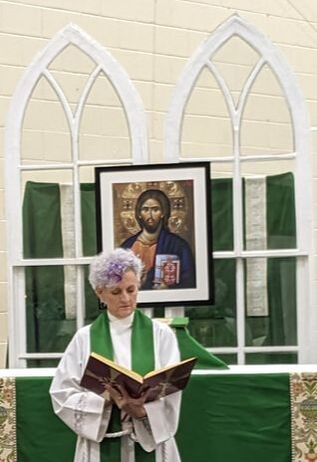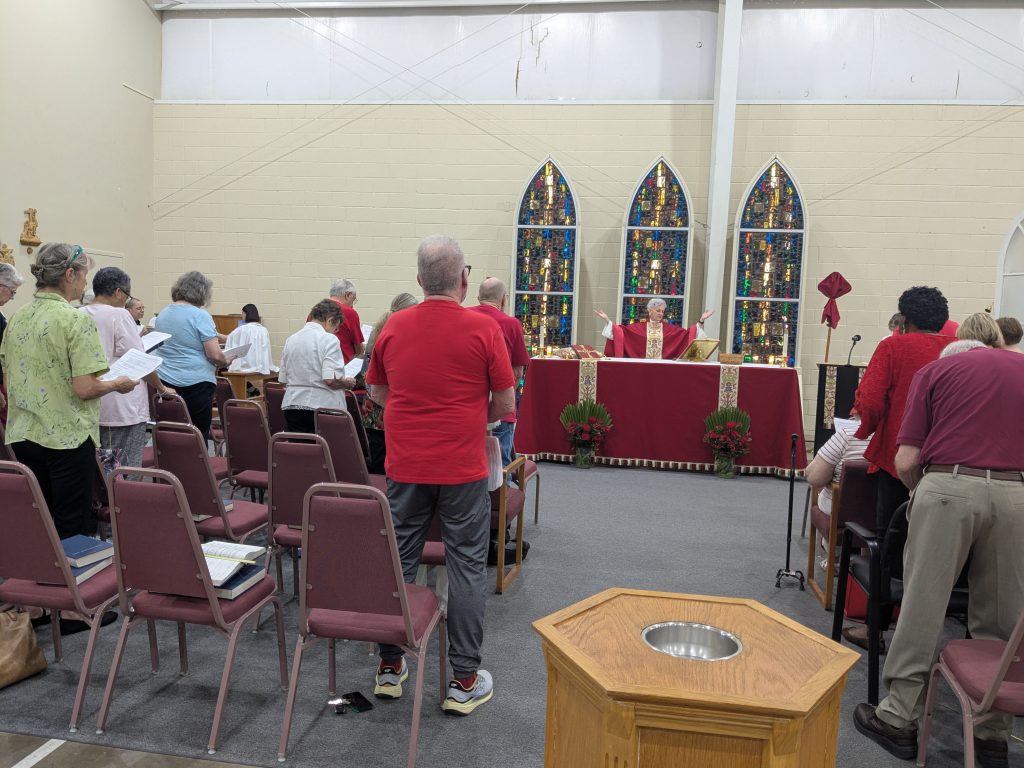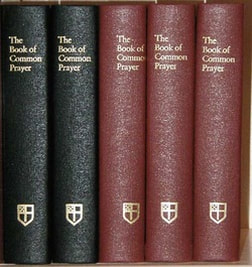Worship
Worship in the Episcopal Church
Join us for worship every Sunday at 10 am, in the Family Life Center at Meadowbrook – Poly United Methodist Church, 2529 Mt. View Avenue, at the corner of Mt. View Avenue and Mt. Vernon Avenue. Parking is directly across the street.
The Place of Worship
As you enter, you will notice an atmosphere of worship and reverence. Episcopal churches are built in many architectural styles; but whether the church is small or large, elaborate or plain, your eye is carried to the altar, or holy table, and to the cross. So our thoughts are taken at once to Christ and to God whose house the church is, no matter the space in which worship is taking place.
On or near the altar there are candles to remind us that Christ is the “Light of the world” (John 8:12). Often there are flowers, to beautify God’s house and to recall the resurrection of Jesus.
On one side at the front, there may be a lectern-pulpit, or stand, for the proclamation of the Word; here the Scriptures are read and the sermon is preached. In many churches, however, the lectern is separate from the pulpit and stands on the opposite side of the church.


Coming and Going
If there are ushers they will greet you, and may escort you to a pew. If you desire, they will answer your questions about the service. Pews are usually unreserved in Episcopal churches. Following the service the pastor greets the people as they leave.
Before and After
It is the custom upon entering church to sit quietly, or, if there are pews, to kneel in one’s pew for a prayer of personal preparation for worship. In many churches it is also the custom to bow to the altar on entering and leaving the church as an act of reverence for Christ.
Most Episcopalians do not talk in church before a service but use this time for personal meditation and devotions. At the end of the service some persons kneel for a private prayer before leaving. Others sometimes sit to listen to the organ postlude. There is usually a Coffee Hour afterward to which all are welcome. There may be a program after church, sometimes called a Forum, which might be a book study or a lecture. Again, all are welcome.
The Act of Worship
Episcopal church services are participatory, involving prayers and responses from the congregation. At St Luke’s you will be given a worship leaflet in which are all are the readings and prayers. The leaflet content is all taken from the Book of Common Prayers and the Lectionary, which is an ordered system for reading the Holy Scriptures at the Eucharist and the Daily Offices. (Find it at
https://www.episcopalchurch.org/lectionary/)
The leaflet also has page numbers in the Hymnal for all the hymns and service music. You also will be given a Hymnal. In many churches with pews you will likely find the Book of Common Prayer. This enables the congregation to share fully in every service. In the Book of Common Prayer, the large print is the actual service. The smaller print gives directions to ministers and people for conduct of the service.
You may wonder when to stand or kneel. Practices vary—even among individual Episcopalians. The general rule is to stand to sing—hymns (found in the Hymnal) and other songs (many of them from the Holy Bible) called canticles or chants and printed as part of the service. We stand, too, to say our affirmation of faith, the Creed; and for the reading of the Gospel in the Holy Eucharist. Psalms are sung or said sitting or standing. We sit during readings from the Old Testament or New Testament Letters, the sermon, and the choir anthems. We stand as able for prayer to show our gratefulness to God for accepting us as children or as an act of humility before God.
What Clergy Wear
To add to the beauty and festivity of the services, and to signify their special ministries, the clergy and other ministers customarily wear vestments. Choir vestments usually consist of an undergown called a cassock (usually black) and a white, gathered overgown called a surplice. The clergy may also wear cassock and surplice.
Another familiar vestment is the alb, a white tunic with sleeves that covers the body from neck to ankles. Over it (or over the surplice) ordained ministers wear a stole, a narrow band of colored fabric. Deacons wear the stole over one shoulder, priests and bishops over both shoulders.
At the Holy Eucharist a bishop or priest frequently wears a chasuble (a circular garment that envelopes the body) over the alb and stole. The deacon’s corresponding vestment has sleeves and is called a dalmatic. Bishops sometimes wear a special head covering called a mitre.
Stoles, chasubles, and dalmatics, as well as altar coverings, are usually made of rich fabrics. Their color changes with the seasons and holy days of the Church Year. The most frequently used colors are white, red, violet, and green.
The Regular Services
The principal service is the Holy Eucharist (Holy Communion). In some Episcopal churches it is celebrated quite simply, without music, early on Sunday morning. Weekday celebrations also are frequently without music, and without sermon. When celebrated at a later hour on Sundays, or on other great Christian days such as Christmas, music and a sermon are customary.
Another service is Morning Prayer. The parallel evening service is Evening Prayer. These services consist of psalms, Bible readings, and prayers; and may include a sermon. They may be with or without music.
While some parts of the services are always the same, others change. At the Holy Eucharist, for example, two or three Bible selections are read. These change each Sunday. So do the psalms. Certain of the prayers also change, in order to provide variety. Page numbers for parts of the service printed elsewhere in the Book are usually announced or given in the service leaflet. But do not be embarrassed to ask your neighbor for the page number.
You will find the services of the Episcopal Church beautiful in their ordered dignity, God-centered, and yet mindful of the nature and needs of human beings.
The Church Year
The Episcopal Church observes the traditional Christian calendar. The season of Advent, during which we prepare for Christmas, begins on the Sunday closest to November 30. Christmas itself lasts twelve days, after which we celebrate the feast of the Epiphany (January 6).
Lent, the forty days of preparation for Easter, begins on Ash Wednesday. Easter season lasts fifty days, concluding on the feast of Pentecost.
During these times the Bible readings are chosen for their appropriateness to the season. During the rest of the year–the season after Epiphany and the long season after Pentecost (except for a few special Sundays)–the New Testament is read sequentially from Sunday to Sunday. The Old Testament lesson corresponds in theme with one of the New Testament readings.
You Will Not be Embarrassed
When you visit an Episcopal church, you will be our respected and welcome guest. You will not be singled out in an embarrassing way, nor asked to stand before the congregation nor to come forward. You will worship God with us.
Should you wish to know more about the Episcopal Church or how one becomes an Episcopalian, the priest will gladly answer your questions and suggest the way to membership.
The Book of Common Prayer
 The Book of Common Prayer is our book of worship and contains private prayers and other services.
The Book of Common Prayer is our book of worship and contains private prayers and other services.
The full title of the Book of Common Prayer is “The Book of Common Prayer and Administration of the Sacraments and other Rites and Ceremonies of the Church.” As it sounds, the BCP includes the common liturgies for all the various rites and practices of the church, including the Morning and Evening Offices, the Eucharist, Ministration to the Sick, Reconciliation of a Penitent, and many others.
A Brief History
The Book of Common Prayer is the primary prayer book of the Church of England. It was one of the instruments of the Protestant Reformation in England, and was also adapted and revised for use in other churches in the Anglican Communion. It replaced the various Latin rites that had been used in different parts of the country with a single compact volume in English. First produced in 1549, it was drastically revised in 1552 and more subtly changed in 1559 and 1662. A modern liturgical text bearing the BCP name is widely used in the Episcopal Church of America as well as some Methodist churches.
You can view an online version of The Book of Common Prayer here.
